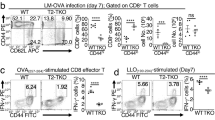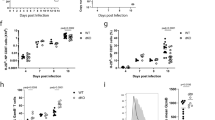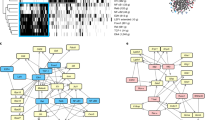Abstract
Transcriptional programs that initiate and sustain the proliferation, differentiation and survival of CD8+ T cells during immune responses are not completely understood. Here we show that inhibitor of DNA binding 2 (Id2), an antagonist of E protein transcription factors, was upregulated in CD8+ T cells during infection and that expression of Id2 was maintained in memory CD8+ T cells. Although Id2-deficient naive CD8+ T cells recognized antigen and proliferated normally early after infection, effector CD8+ T cells did not accumulate because the cells were highly susceptible to apoptosis. Id2-deficient CD8+ T cells responding to infection had changes in the expression of genes that influence survival and had altered memory formation. Our data emphasize the importance of Id2 in regulating gene expression by CD8+ T cells and the magnitude of effector responses, suggesting a mechanism involving Id protein– and E protein–mediated survival and differentiation of mature T cells.
This is a preview of subscription content, access via your institution
Access options
Subscribe to this journal
Receive 12 print issues and online access
$209.00 per year
only $17.42 per issue
Buy this article
- Purchase on SpringerLink
- Instant access to full article PDF
Prices may be subject to local taxes which are calculated during checkout








Similar content being viewed by others
References
Kaech, S.M., Wherry, E.J. & Ahmed, R. Effector and memory T-cell differentiation: implications for vaccine development. Nat. Rev. Immunol. 2, 251–262 (2002).
Kaech, S.M., Hemby, S., Kersh, E. & Ahmed, R. Molecular and functional profiling of memory CD8 T cell differentiation. Cell 111, 837–851 (2002).
Goldrath, A.W., Luckey, C.J., Park, R., Benoist, C. & Mathis, D. The molecular program induced in T cells undergoing homeostatic proliferation. Proc. Natl. Acad. Sci. USA 101, 16885–16890 (2004).
Glimcher, L.H., Townsend, M.J., Sullivan, B.M. & Lord, G.M. Recent developments in the transcriptional regulation of cytolytic effector cells. Nat. Rev. Immunol. 4, 900–911 (2004).
Intlekofer, A.M. et al. Effector and memory CD8+ T cell fate coupled by T-bet and eomesodermin. Nat. Immunol. 6, 1236–1244 (2005).
Pearce, E.L. et al. Control of effector CD8+ T cell function by the transcription factor eomesodermin. Science 302, 1041–1043 (2003).
Sullivan, B.M., Juedes, A., Szabo, S.J., von Herrath, M. & Glimcher, L.H. Antigen-driven effector CD8 T cell function regulated by T-bet. Proc. Natl. Acad. Sci. USA 100, 15818–15823 (2003).
Taniuchi, I. et al. Differential requirements for Runx proteins in CD4 repression and epigenetic silencing during T lymphocyte development. Cell 111, 621–633 (2002).
Liou, H.C. et al. c-Rel is crucial for lymphocyte proliferation but dispensable for T cell effector function. Int. Immunol. 11, 361–371 (1999).
Murre, C. Helix-loop-helix proteins and lymphocyte development. Nat. Immunol. 6, 1079–1086 (2005).
Rivera, R.R., Johns, C.P., Quan, J., Johnson, R.S. & Murre, C. Thymocyte selection is regulated by the helix-loop-helix inhibitor protein, Id3. Immunity 12, 17–26 (2000).
Yokota, Y. et al. Development of peripheral lymphoid organs and natural killer cells depends on the helix-loop-helix inhibitor Id2. Nature 397, 702–706 (1999).
Yokota, Y. et al. The helix-loop-helix inhibitor Id2 and cell differentiation control. Curr. Top. Microbiol. Immunol. 251, 35–41 (2000).
Fukuyama, S. et al. Initiation of NALT organogenesis is independent of the IL-7R, LTbetaR, and NIK signaling pathways but requires the Id2 gene and CD3−CD4+CD45+ cells. Immunity 17, 31–40 (2002).
Kim, J.K., Takeuchi, M. & Yokota, Y. Impairment of intestinal intraepithelial lymphocytes in Id2 deficient mice. Gut 53, 480–486 (2004).
Hacker, C. et al. Transcriptional profiling identifies Id2 function in dendritic cell development. Nat. Immunol. 4, 380–386 (2003).
Quong, M.W., Romanow, W.J. & Murre, C. E protein function in lymphocyte development. Annu. Rev. Immunol. 20, 301–322 (2002).
Goldfarb, A.N., Flores, J.P. & Lewandowska, K. Involvement of the E2A basic helix-loop-helix protein in immunoglobulin heavy chain class switching. Mol. Immunol. 33, 947–956 (1996).
Quong, M.W., Harris, D.P., Swain, S.L. & Murre, C. E2A activity is induced during B-cell activation to promote immunoglobulin class switch recombination. EMBO J. 18, 6307–6318 (1999).
Quong, M.W. et al. Receptor editing and marginal zone B cell development are regulated by the helix-loop-helix protein, E2A. J. Exp. Med. 199, 1101–1112 (2004).
Pan, L., Sato, S., Frederick, J.P., Sun, X.H. & Zhuang, Y. Impaired immune responses and B-cell proliferation in mice lacking the Id3 gene. Mol. Cell. Biol. 19, 5969–5980 (1999).
Sugai, M. et al. Essential role of Id2 in negative regulation of IgE class switching. Nat. Immunol. 4, 25–30 (2003).
Sugai, M., Gonda, H., Nambu, Y., Yokota, Y. & Shimizu, A. Role of Id proteins in B lymphocyte activation: new insights from knockout mouse studies. J. Mol. Med. 82, 592–599 (2004).
Pan, L., Bradney, C., Zheng, B. & Zhuang, Y. Altered T-dependent antigen responses and development of autoimmune symptoms in mice lacking E2A in T lymphocytes. Immunology 111, 147–154 (2004).
Luckey, C.J. et al. Memory T and memory B cells share a transcriptional program of self-renewal with long-term hematopoietic stem cells. Proc. Natl. Acad. Sci. USA 103, 3304–3309 (2006).
Zhang, M. et al. Serine protease inhibitor 6 protects cytotoxic T cells from self-inflicted injury by ensuring the integrity of cytotoxic granules. Immunity 24, 451–461 (2006).
Marzo, A.L. et al. Initial T cell frequency dictates memory CD8+ T cell lineage commitment. Nat. Immunol. 6, 793–799 (2005).
Williams, M.A. & Bevan, M.J. Shortening the infectious period does not alter expansion of CD8 T cells but diminishes their capacity to differentiate into memory cells. J. Immunol. 173, 6694–6702 (2004).
van Faassen, H. et al. Reducing the stimulation of CD8+ T cells during infection with intracellular bacteria promotes differentiation primarily into a central (CD62LhighCD44high) subset. J. Immunol. 174, 5341–5350 (2005).
Ikawa, T., Kawamoto, H., Goldrath, A.W. & Murre, C. E proteins and Notch signaling cooperate to promote T cell lineage specification and commitment. J. Exp. Med. 203, 1329–1342 (2006).
Engel, I. & Murre, C. Ectopic expression of E47 or E12 promotes the death of E2A-deficient lymphomas. Proc. Natl. Acad. Sci. USA 96, 996–1001 (1999).
Engel, I. & Murre, C. E2A proteins enforce a proliferation checkpoint in developing thymocytes. EMBO J. 23, 202–211 (2004).
Liu, N. et al. Serine protease inhibitor 2A is a protective factor for memory T cell development. Nat. Immunol. 5, 919–926 (2004).
Schwartz, R., Engel, I., Fallahi-Sichani, M., Petrie, H.T. & Murre, C. Gene expression patterns define novel roles for E47 in cell cycle progression, cytokine-mediated signaling, and T lineage development. Proc. Natl. Acad. Sci. USA 103, 9976–9981 (2006).
Williams, M.A., Tyznik, A.J. & Bevan, M.J. Interleukin-2 signals during priming are required for secondary expansion of CD8+ memory T cells. Nature 441, 890–893 (2006).
Badovinac, V.P., Porter, B.B. & Harty, J.T. CD8+ T cell contraction is controlled by early inflammation. Nat. Immunol. 5, 809–817 (2004).
Janssen, E.M. et al. CD4+ T cells are required for secondary expansion and memory in CD8+ T lymphocytes. Nature 421, 852–856 (2003).
Bain, G. et al. Regulation of the helix-loop-helix proteins, E2A and Id3, by the Ras-Erk MAPK cascade. Nat. Immunol. 2, 165–171 (2001).
Acknowledgements
We thank C. Murre for providing Id2-deficient mice and discussions; S. Hedrick, G. Barton and J. Hamerman for advice and critical review of the manuscript; and D. Mathis, C. Benoist and M. Bevan for their support. Supported by the Cancer Research Foundation (A.W.G.), the V Foundation for Cancer Research (A.W.G.), the US National Institutes of Health (AI067545 to A.W.G.) and the Doris A. Howell Foundation (N.A.L.).
Author information
Authors and Affiliations
Corresponding author
Ethics declarations
Competing interests
The authors declare no competing financial interests.
Supplementary information
Supplementary Fig. 1
Generation of Id2-deficient mice by gene targeting. (PDF 577 kb)
Supplementary Fig. 2
Impaired polyclonal immune response of Id2-deficient CD8+ T cells to Lm-OVA infection. (PDF 1318 kb)
Supplementary Fig. 3
Id2-deficient OT-I thymocytes and splenocytes respond normally to antigen. (PDF 731 kb)
Supplementary Fig. 4
Quantitative PCR comparison of gene expression by Id2-deficient and Id2-wildtype OT-I effector T cells. (PDF 759 kb)
Rights and permissions
About this article
Cite this article
Cannarile, M., Lind, N., Rivera, R. et al. Transcriptional regulator Id2 mediates CD8+ T cell immunity. Nat Immunol 7, 1317–1325 (2006). https://doi.org/10.1038/ni1403
Received:
Accepted:
Published:
Issue Date:
DOI: https://doi.org/10.1038/ni1403



